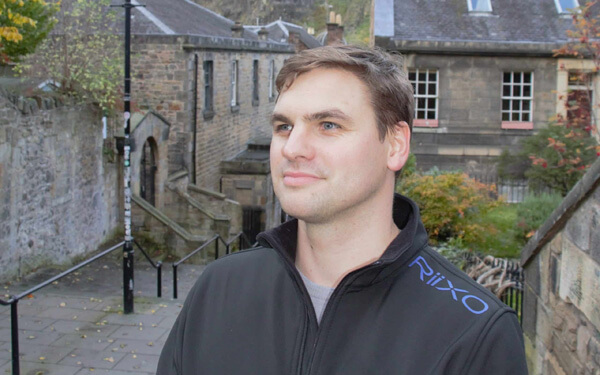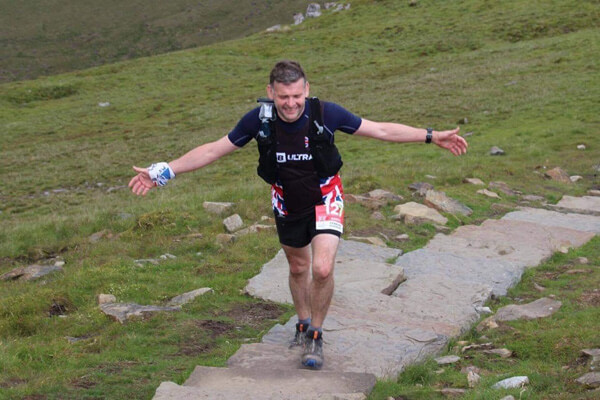
This is a series of posts following Gareth Kilshaw's preparations for an 127-mile ultramarathon.
In this post we focus on recovery. When Cameron, Founder of Riixo, heard about Gareth’s plans he was keen to join the team. He designed a recovery plan to fit into Gareth’s training and his home-life to maximise his recovery.
Prior to this challenge, Gareth had never bothered much with a recovery plan.
A long weekend run would be followed by a rest day on the following Monday, in which he’d focus on refuelling by simply “getting some good food in him”.
Other than that, he didn’t do much.
“I have a massage every now and then but certainly I don’t do enough stretching. That’s something I needed to work on,” he says.
Being sore the day after a long run was something he thought was normal. He’d just slog through the first few miles in pain.
Fortunately, Cameron Johnston has introduced him to active recovery; one of a number of methods for Gareth to prioritise after his runs.
Cameron is a former professional rugby player, a physio in the military, and the founder of Riixo, a specialist sports and injury recovery brand. He focuses on speeding up muscle recovery in sport as well as aiding soft tissue recovery in injury.

Cameron says that ideologies about how athletes recover from intense training have changed significantly in recent years. There’s now a greater focus on active recovery.
“When it comes to your recovery, timing is everything. And it starts the moment you cross the finish line. Especially if you’ve just completed a long run.”
Many runners find it difficult to fit recovery in around other commitments. But a good recovery plan should fit seamlessly into life so you don’t have to think about it, says Cameron. The aim is to allow your body to build up again for the next big effort or performance.
Active recovery
Active recovery is simply low-intensity exercise (major muscle groups used in training or competition) that let your body know you’ve finished exercising. These exercises are also designed to help with lactic acid removal and muscle cell recovery.
Cameron explains that active recovery can take two forms. The first option is to take a 15-20 minute walk at the end of a long run. This allows the body to “wind down”.
“If you’ve put a lot of demand on your body and then you suddenly stop, you’ll be putting it into a state of shock,” Cameron says. “Your body’s gone from a high work rate to nothing so all the lactic acid and byproducts from your muscles working will just sit in your muscles.”
Our bodies aren’t very efficient at shifting those byproducts out on their own, especially in muscles that have to fight against gravity. The longer that lactic acid sits in the muscles, the more likely you are to wind up with DOMS. Lactic acid will cause the muscles to seize up as the sudden reduction in activity and heart rate will hinder the removal of lactic acid and other waste products. In simple terms, it will lead to really bad DOMS over the next 48-72hrs.
Finishing a run with a 15-20 minute walk or a steady-state jog will allow your heart rate to return to normal. At the same time, the flood of blood and oxygen to the muscles will the body process those byproducts. It will also help bring your heart rate down and control your breathing whilst still moving blood around, which will prevent pooling.
Cameron explains that in the calves especially, the muscles work like a pump.
“The blood gets down to the calf easily as it is helped by gravity, but it’s a lot of work to get back to the heart and lungs again. Every time you take a step and contract the calf muscle it helps to keep that blood flow moving around the body, and with it any waste products in the muscle built up from running.”
The 24 hours following a long run are also important. This is when low-impact activity is best: a half-hour walk, swimming, yoga, or a gym session at 20 per cent your usual effort.
“You might have only run for an hour, but those other 23 hours are important for your body’s recovery,” Cameron says.
Managing inflammation
Inflammation is a natural response to injury. For example, if you roll your ankle and it swells up, it could be that you’ve torn something and your body is repairing itself.
Cameron says that the same process occurs in muscles but at a microscopic level.
“When you run, you damage some of the fibres that are in the muscle. Then what your body does in recovery is repair them. So, you’ll get a natural inflammatory response.”
Sometimes, this muscle inflammation can make your legs feel like they’re rock solid - especially after a heavy hill session. That’s when ice and compression are crucial for recovery.
Ice
Active recovery should be immediately followed by cooling the muscles, but it’s still important to keep the body moving.
There are a number of benefits to ice, which is why so many professional athletes depend on it
Of course, most forms of cooling therapy don’t allow you to move (e.g., sitting in a bath of ice or using an ice pack). This is why Cameron designed the Riixo Recovery cuffs. They provide ice and compression but still facilitate movement. The cuffs are convenient and easy to use, and make recovery effortless.
Rehydration
Research has shown that muscle soreness experienced by endurance athletes after training and completing an event is worse in those who don’t rehydrate shortly afterwards.
Gareth’s 127-mile challenge will mean many, many training runs and he needs to hydrate both during and after. Cameron has recommended a plan in which he should be replacing 125-150% of fluid lost during exercise within 2-6 hours.
This can be worked out with a simple equation where 1kg bodyweight = 1L of water. If Gareth weighs 80kg before a run and 79kg after the run, he will have lost 1l of water weight.
This means he needs to drink 1.25l of water to replace it.
Contrast therapy
Involves exposing the body to brief bursts of hot and cold temperatures, such as ice baths and spas or showers.
As with ice and compression, the idea of contrast therapy is to encourage vasoconstriction. When used immediately after ice, you’ll be helping to initiate a physiological change in the muscles and blood vessels. The heat will cause vasodilation, making the blood vessels expand and increasing the volume of blood into the muscles.
Benefits of contrast therapy:
Static Stretching
Runners often complain that the most difficult part of stretching is getting around to doing it.
However, stretching the muscles after exercise is imperative, says Cameron. It helps to relax the muscles and increase range of motion. This will not only accelerate recovery but reduce injury risk and enhance performance the next time you train or compete.
Stretching must be carried out while the body is at rest. Each stretching position is held at a stable position for 15-20 seconds.
The trick, Cameron says, is to stretch little and often.
“If you’re making a cup of tea, here’s nothing stopping you from doing a calf stretch while you're standing at the kitchen sink,” Cameron says. “You can even do a few hamstring stretches while watching TV.”
Stretching throughout the day like this will help keep the muscles warm and prevent cramping.
A great way to kill two birds with one stone is to do some stretches in the shower. The hot water will improve elasticity in the muscles and help prevent them from tightening and cramping.

Compression
Compression works by improving circulation and lymph drainage. It also increases oxygen levels and supports your body ability to project itself.
“When you apply gradient compression to specific muscles in a balanced and accurate way, you can accelerate blood flow,” says Cameron. “This means you get more oxygen to your working muscles. Compression applies pressure to these ‘blue’ veins which lie closest to the skin, accelerating the blood flow back to the heart.”
Lymphatic drainage is the body’s ability to remove, process and absorb excess fluid. Better blood flow and lymphatic drainage help your body to get rid of lactic acid and other by-products of exercise that cause muscle soreness. In addition, the improved oxygen levels to the muscles help to accelerate muscle repair.
Eat and refuel
As with any training plan, Gareth should aim to eat small meals every few hours to refill his body’s energy stores. This will also help supply his muscles with the required energy required to repair muscle damage.
“Eating smaller meals at frequent intervals will make it easier for your body to digest,” says Cameron. “To digest large meals your body needs to redirect blood flow to the gut, which will result in you feeling lethargic and tired. Think of a large Christmas or Thanksgiving meal and how you feel when you’ve finished!”

Read more:
Review: Find out what Gareth thought of the calf cuff after putting it through its paces
Training plan: What the recovery powers the batteries for
Nutrition : To keep the furnace stoked, see what Lauren changed in Gareth’s diet
Kit : Tried, tested and travelled. The gear and the pack partnering Gareth from Liverpool to Leeds

 Cracking The Injury Risk Equation
Cracking The Injury Risk Equation
 LJMU Study Findings
LJMU Study Findings
 What are shin splints?
What are shin splints?
 How to treat shin splints [2021]
How to treat shin splints [2021]
No Thanks – I’ll pay full price
Close Window
Close Window
[…] do you get when you add up 12 weeks of training, a new diet, a recovery plan, targeted strength work, the “Carlsberg” of crews, 30+ hours of running, and 128 miles […]
[…] can read about the team, the training plan, his recovery protocols, nutrition and his kit selection […]
[…] is the training plan but he has also considered his strength training, his nutrition, how he has recovered and even how he’s […]
[…] Recovery – The yin to the yang. How Gareth balanced recovery, running & life […]
[…] documented some of his preparations, his training, nutrition, strength & conditioning and recovery. In this post we look at the kit that Gareth has selected to make the journey with […]
[…] https://riixo.com/gareth-127-ultra-recovery/ […]
[…] speak to Gareth and his team, look at the training plan, recovery protocols, strength work and his […]